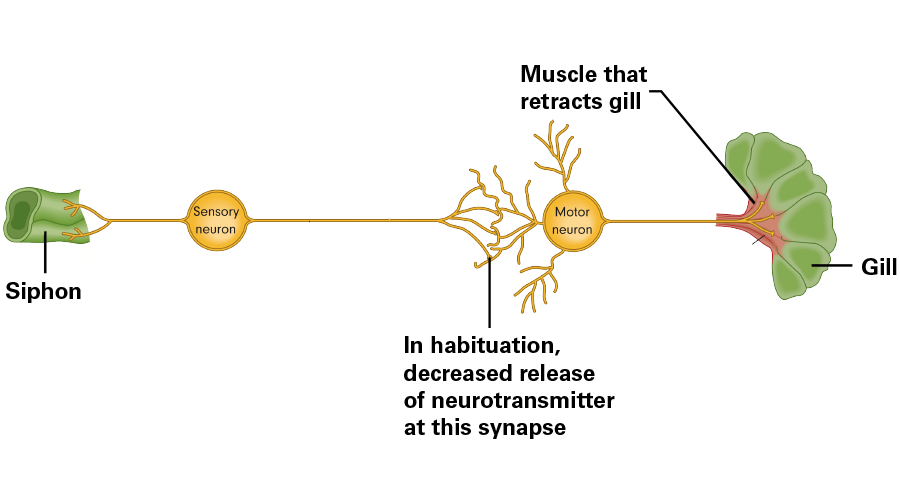METHODS TO STUDY LEARNING AND MEMORY
2.3
The role of synaptic plasticity in memory
What happens during learning and how is memory stored? Read this article by Dominique de Quervain.
Although this course focuses on human memory, I would like to briefly mention some of the essential discoveries that have been made about what happens on the neurobiological level during learning and memory processes. Eric Kandel is one of several researchers to pioneer this approach and was awarded with the Nobel Prize in 2000 for his work. He started his studies by examining the sea slug aplysia.
If you touch the aplysia’s siphon, its gill retracts (similar to how a snail’s tentacles retract after touching them). If you touch the siphon repeatedly, the retraction reflex becomes weaker and weaker. This is a very simple form of memory, but it is memory nonetheless since the aplysia remembers that you have touched it before. What is the neurobiological basis of this memory? There are two neurons involved in the retraction reflex: a sensory neuron and a motor neuron.

Figure 1: The neuronal circuitry of habitation in the sea slug aplysia. Shutterstock.
Once the sensory neuron has fired repeatedly, the neurotransmitter becomes used up, and thus less and less neurotransmitter is released. As a consequence, the postsynaptic motor neuron becomes less and less stimulated, and the reflex becomes weaker and weaker. This phenomenon is called habituation. It means that the neurobiological mechanism of habituation is based on the reduced availability of the neurotransmitter at the presynaptic neuron.
Now let’s look at a more complex memory process: sensitization. If you electrically stimulate the tail of the aplysia and then touch the siphon, you will observe a much stronger retraction reflex. Kandel was able to show that the electrical stimulus (through another neural circuit) enhanced neurotransmitter release at the sensory neuron. Furthermore, he observed that after repeated electrical stimulation, there was a stronger retraction upon touching the siphon for several days. The basis of this long-term memory was the formation of new synapses between the sensory neuron and the motor neuron. Kandel also described the genetic and molecular processes involved in the production of new proteins that are required for these new synapses to form.
See this movie on how a new synapse is formed.
So, memory depends on synaptic plasticity, i.e. the ability of synapses to change their biochemistry or structure in response to a stimulus. Synaptic plasticity is thought to underlie learning and memory in all species, including humans. Although genetic and molecular processes cannot be studied in humans directly, a study with my dear colleague Andreas Papassotiropoulos showed that genetic variations in human homologues of memory-related genes, as described by Kandel and others, are related to inter-individual differences in human memory performance (de Quervain and Papassotiropulos, 2006).
References
de Quervain and Papassotiropulos, Proc Natl Acad Sci U S A. 2006 Mar 14; 103 (11): 4270-4. doi: 10.1073/pnas.0510212103.
License
University of Basel
